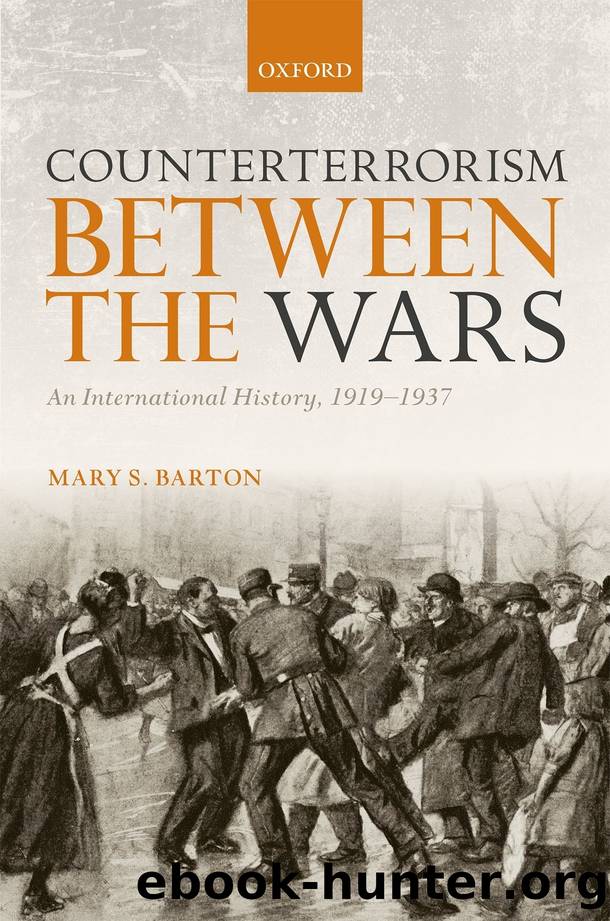Counterterrorism Between the Wars by Mary S. Barton

Author:Mary S. Barton [Barton, Mary S.]
Language: eng
Format: epub
ISBN: 9780192609557
Publisher: OUP Oxford
Published: 2020-10-23T00:00:00+00:00
U.S. Foreign Intelligence and the Global Arms Trade
Commanding an arms control agreement to Congress required accurate foreign intelligence, which meant sustaining an effective intelligence apparatus even in peacetime. In February 1925, in preparation for the upcoming conference, the State Department directed U.S. diplomatic missions abroad to gather information on the global arms trade. An intelligence-coordinating unit in the Office of the Under Secretary of State, which had subsumed the Office of the Counselor and its foreign intelligence section following the end of the Great War, oversaw the operation. Information was also routed to Dulles, who would go on to lead the Office of Strategic Services (OSS) operations in Berne during the Second World War and the Central Intelligence Agency (CIA) after that. As described in Chapter 3, Assistant Secretary of State Leland Harrison, who had been the wartime âdiplomatic secretaryâ in the Office of the Counselor, retained his portfolio to centralize and interpret information gathered from the Departments of Justice, Army, and the Navy. Diplomats as well as naval and military attachés representing the Office of Naval Intelligence (ONI) and the Armyâs Military Information Division (MID) were instructed to seek out information about arms exports and imports through informal conversations and inquiries, and to promise that information would not be shared with other governments or delegations.29
State Department officials had initially expressed skepticism of European intentions when Hughes instructed Grew to attend TMC meetings in February 1924. âThe end which they have in viewâ was indeed âto protect existing governments while leaving them free as between themselves to make and supplyâ arms, Hornbeck wrote Harrison on February 8, quoting Hughesâs cable of February 2. Hornbeck went on to say: âThe real object throughout is to enhance and strengthen the authority of the major European powers in various regions of the world in which political conditions are unstableâparticularly in Africa and in Asia; the method envisaged is that of overcoming political opposition by rendering physical opposition impossible.â30
In the spring of 1925, however, State Department officials described a world awash in guns, and a free flow of arms and military equipment across nations and continents. These weapons may not have been generating interstate conflict, but they were aiding ultra-nationalist and irredentist terrorist organizations, encouraging ethnic and political violence, and inciting clashes between communist and anti-communist factions. Information from U.S. foreign missions alerted the State Department about Soviet Russiaâs military rearmament, which was aided by German firms and expertise, and the threat this posed to the fragile order of east-central Europe. According to an American military attaché stationed in London, the Soviet government operated aircraft factories, artillery works, and chemical warfare plants in numerous cities, all of which were âunder the directionâ of Germans. Moscow was âactively preparing in a military way more than any other country in Europe,â according to the attaché. He reported that some fifty tons of war materials were shipped from Germany to Russia during 1924.31 Rumors of a secret military agreement had followed the restoration of diplomatic relations through the April 1922 Treaty of Rapallo, yet the German government had officially denied the allegations.
Download
This site does not store any files on its server. We only index and link to content provided by other sites. Please contact the content providers to delete copyright contents if any and email us, we'll remove relevant links or contents immediately.
The European History Highway: A Guide to Internet Resources by Dennis A. Trinkle Scott A. Merriman(492)
The Seven Wonders of the Ancient World by Michael Denis Higgins(476)
European Security in a Global Context by Thierry Tardy(468)
European Security without the Soviet Union by Stuart Croft Phil Williams(468)
The Routledge companion to Christian ethics by D. Stephen Long Rebekah L. Miles(457)
Hudud Al-'Alam 'The Regions of the World' - a Persian Geography 372 A.H. (982 AD) by V. V. Minorsky & C. E. Bosworth(398)
Gorbachev And His Generals by William C. Green(390)
Get Real with Storytime by Julie Dietzel-Glair & Marianne Crandall Follis(388)
Tibetan Studies in Comparative Perspective by Chih-yu Shih Yu-Wen Chen(385)
Governance, Growth and Global Leadership by Espen Moe(380)
Hyperculture by Byung-Chul Han(375)
CliffsNotes on Fitzgerald's The Great Gatsby by Kate Maurer(359)
The Oxford History of the World by Fernández-Armesto Felipe;(353)
How Languages Are Learned 5th Edition by Patsy M Lightbown;Nina Spada; & Nina Spada(352)
The Egyptian Economy, 1952-2000 by Khalid Ikram(349)
Oral Poetry and Narratives from Central Arabia: The Poetry of Ad-Dindan : A Bedouin Bard in Southern Najd (Studies in Arabic Literature, Vol 17) (English and Arabic Edition) by P. M. Kupershoek P. Marcel Kurpershoek(341)
The Oxford Handbook of the Incas by Sonia Alconini(333)
Europe Contested by Harold James(319)
The Hutchinson Dictionary of Ancient and Medieval Warfare by Peter Connolly John Gillingham John Lazenby(304)
